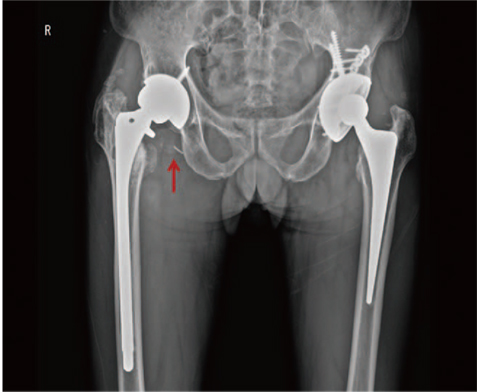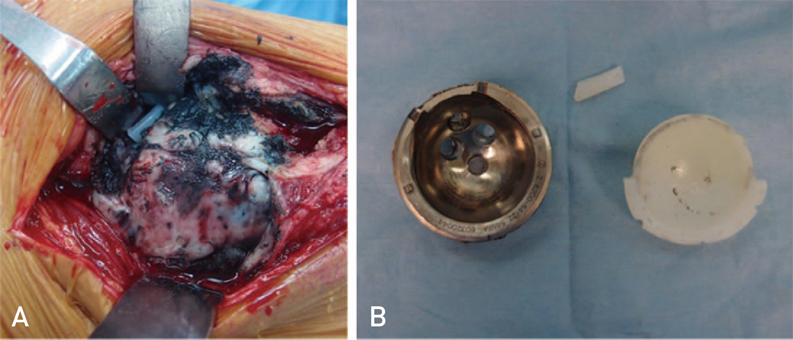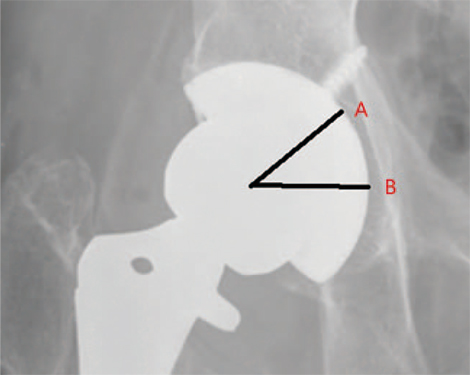Hip Pelvis.
2015 Sep;27(3):192-195. 10.5371/hp.2015.27.3.192.
A Liner Breakage in Total Hip Arthroplasty after Using 1st Generation Highly Cross Linked Polyethylene Mated against 36-mm Metal Head: A Case Report
- Affiliations
-
- 1Department of Orthopaedic Surgery, Daegu Catholic University College of Medicine, Daegu, Korea. cmr0426@cu.ac.kr
- KMID: 2069151
- DOI: http://doi.org/10.5371/hp.2015.27.3.192
Abstract
- It has been known the highly cross linked polyethylene (HXLPE) has an advantage of improved wear rate. However, the alteration in mechanical properties such as decreased tensile yield and fatigue strength make concerns about fragility of HXLPE. We experienced a case of HXLPE breakage. But, this case of liner breakage happened although patient belonged to normal BMI and proper acetabular cup position so called "safe zone" on radiographs. So, we report this case with reference review.
Keyword
Figure
Reference
-
1. Soong M, Rubash HE, Macaulay W. Dislocation after total hip arthroplasty. J Am Acad Orthop Surg. 2004; 12:314–321.
Article2. Johnson AJ, Loving L, Herrera L, Delanois RE, Wang A, Mont MA. Short-term wear evaluation of thin acetabular liners on 36-mm femoral heads. Clin Orthop Relat Res. 2014; 472:624–629.
Article3. Lee JH, Lee BW, Lee BJ, Kim SY. Midterm results of primary total hip arthroplasty using highly cross-linked polyethylene: minimum 7-year follow-up study. J Arthroplasty. 2011; 26:1014–1019.
Article4. Harris WH, Muratoglu OK. A review of current cross-linked polyethylenes used in total joint arthroplasty. Clin Orthop Relat Res. 2005; (430):46–52.
Article5. Pruitt LA. Deformation, yielding, fracture and fatigue behavior of conventional and highly cross-linked ultra high molecular weight polyethylene. Biomaterials. 2005; 26:905–915.
Article6. Tower SS, Currier JH, Currier BH, Lyford KA, Van Citters DW, Mayor MB. Rim cracking of the cross-linked longevity polyethylene acetabular liner after total hip arthroplasty. J Bone Joint Surg Am. 2007; 89:2212–2217.
Article7. Waewsawangwong W, Goodman SB. Unexpected failure of highly cross-linked polyethylene acetabular liner. J Arthroplasty. 2012; 27:323.e1–323.e4.
Article8. Moore KD, Beck PR, Petersen DW, Cuckler JM, Lemons JE, Eberhardt AW. Early failure of a cross-linked polyethylene acetabular liner. A case report. J Bone Joint Surg Am. 2008; 90:2499–2504.9. Berry DJ, Barnes CL, Scott RD, Cabanela ME, Poss R. Catastrophic failure of the polyethylene liner of uncemented acetabular components. J Bone Joint Surg Br. 1994; 76:575–578.
Article10. Puértolas JA, Medel FJ, Cegoñino J, Gomez-Barrena E, Ríos R. Influence of the remelting process on the fatigue behavior of electron beam irradiated UHMWPE. J Biomed Mater Res B Appl Biomater. 2006; 76:346–353.
Article
- Full Text Links
- Actions
-
Cited
- CITED
-
- Close
- Share
- Similar articles
-
- Results of Total Hip Arthroplasty with 36-mm Metallic Femoral Heads on 1st Generation Highly Cross Linked Polyethylene as a Bearing Surface in Less than Forty Year-old Patients: Minimum Ten-year Results
- Results of Primary Total Hip Arthroplasty Using 36 mm Femoral Heads on 1st Generation Highly Cross Linked Polyethylene in Patients 50 Years and Less with Minimum Five Year Follow-up
- Ceramic Head Fracture in Ceramic-on-Polyethylene Total Hip Arthroplasty
- Dissociation of Polyethylene liner in Metal backed Cup without Hip Dislocation History: A Case Report
- An Inguinal Mass associated with Polyethylene Wear Debris after a Total Hip Arthroplasty: A Case Report





